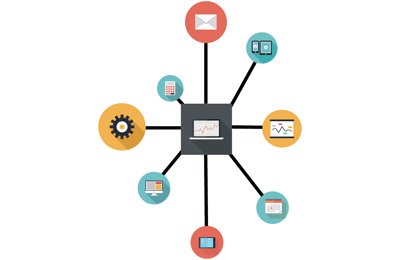“Business Process Management (BPM) is a discipline involving any combination of modeling, automation, execution, control, measurement and optimization of business activity flows, in support of enterprise goals, spanning systems, employees, customers and partners within and beyond the enterprise boundaries.”

OPERATIONAL INTELIGENCE
BPM is now considered a critical component of operational intelligence (OI) solutions to deliver real-time, actionable information. This real-time information can be acted upon in a variety of ways - alerts can be sent or executive decisions can be made using real-time dashboards. OI solutions use real-time information to take automated action based on pre-defined rules so that security measures and or exception management processes can be initiated.
As such, some people view BPM as "the bridge between Information Technology and Business.". In fact, an argument can be made that this "holistic approach" bridges organizational and technological silos.
BUSINESS DRIVERS
BPM addresses many of the critical IT issues underpinning these business drivers, including:
Managing end-to-end, customer-facing processes.
Consolidating data and increasing visibility into and access to associated data and information.
Increasing the flexibility and functionality of current infrastructure and data.
Integrating with existing systems and leveraging service oriented architecture (SOAs).
Establishing a common language for business - IT alignment.

B P M LIFE CYCLE
Business process management activities can be arbitrarily grouped into categories such as design, modeling, execution, monitoring, and optimization.
Process design encompasses both the identification of existing processes and the design of "to-be" processes. Areas of focus include representation of the process flow, the actors within it, alerts & notifications, escalations, standard operating procedures, service level agreements, and task hand-over mechanisms.
Good design reduces the number of problems over the lifetime of the process. Whether or not existing processes are considered, the aim of this step is to ensure that a correct and efficient theoretical design is prepared.
The proposed improvement could be in human-to-human, human-to-system, and system-to-system workflows, and might target regulatory, market, or competitive challenges faced by the businesses.
Modeling takes the theoretical design and introduces combinations of variables (e.g., changes in rent or materials costs, which determine how the process might operate under different circumstances).
It also involves running "what-if analysis" on the processes: "what if i have 75% of resources to do the same task?", "What if i want to do the same job for 80% of the current cost?
One of the ways to automate processes is to develop or purchase an application that executes the required steps of the process; however, in practice, these applications rarely execute all the steps of the process accurately or completely. Another approach is to use a combination of software and human intervention; however this approach is more complex, making the documentation process difficult.
As a response to these problems, software has been developed that enables the full business process (as developed in the process design activity) to be defined in a computer language which can be directly executed by the computer. the system will either use services in connected applications to perform business operations (e.g. calculating a repayment plan for a loan) or, when a step is too complex to automate, will ask for human input. Compared to either of the previous approaches, directly executing a process definition can be more straightforward and therefore easier to improve. However, automating a process definition requires flexible and comprehensive infrastructure, which typically rules out implementing these systems in a legacy it environment.
Monitoring encompasses the tracking of individual processes, so that information on their state can be easily seen, and statistics on the performance of one or more processes can be provided. An example of the tracking is being able to determine the state of a customer order (e.g. ordered arrived, awaiting delivery, invoice paid) so that problems in its operation can be identified and corrected.
In addition, this information can be used to work with customers and suppliers to improve their connected processes. Examples of the statistics are the generation of measures on how quickly a customer order is processed or how many orders were processed in the last month. These measures tend to fit into three categories: cycle time, defect rate and productivity.
The degree of monitoring depends on what information the business wants to evaluate and analyze and how business wants it to be monitored, in real-time, near real-time or ad-hoc. Here, business activity monitoring (BAM) extends and expands the monitoring tools in generally provided by BPMs.
Process mining is a collection of methods and tools related to process monitoring. The aim of process mining is to analyze event extracted through process monitoring and to compare them with an a priori process model. Process mining allows process analysts to detect discrepancies between the actual process execution and the a priori model as well as to analyze bottlenecks.
Process optimization includes retrieving process performance information from modeling or monitoring phase; identifying the potential or actual bottlenecks and the potential opportunities for cost savings or other improvements; and then, applying those enhancements in the design of the process. Overall, this creates greater business value.


